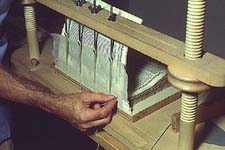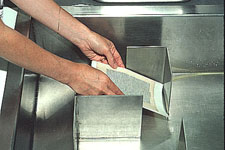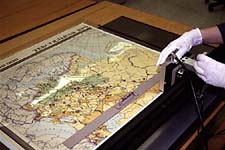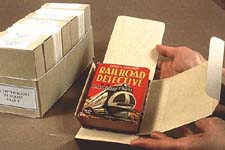Services of the Conservation Division
The Conservation Division is responsible for managing the Library's program of providing conservation treatment and preventive conservation for materials that are high priority or at risk and for selected rare and intrinsically valuable collection materials in the permanent research collections.
The Conservation Division oversees all work involving single-item and
collection-level conservation treatment, including but not limited to,
chemical stabilization and physical treatment of maps, manuscripts, prints
and drawings, book materials, and photographic materials. Working closely
with the Preservation Research and Testing Division, and in coordination
with other offices, as appropriate, the Conservation Division establishes
criteria and standards for supplies and techniques used in the Library's
conservation, housing, and storage activities. The Conservation Division
also works to ensure that all collection materials are displayed, housed,
and stored under appropriate environmental conditions.
 The Conservation Division
at the Library of Congress has been a world leader in developing the
profession of library conservation as we now know it. Many innovative
treatments have been developed in its laboratory over the years. A brief
discussion of some of them suggests both the complexity of the materials
held by the Library of Congress and the ingenuity used to treat and maintain
them.
The Conservation Division
at the Library of Congress has been a world leader in developing the
profession of library conservation as we now know it. Many innovative
treatments have been developed in its laboratory over the years. A brief
discussion of some of them suggests both the complexity of the materials
held by the Library of Congress and the ingenuity used to treat and maintain
them.
Drawing by Dr. Seuss
A pen and ink drawing in the Swann Collection by Theodore Geisel (aka Dr. Seuss) was treated by a Senior Paper Conservator. The cartoon, published in a 1931 issue of Judge magazine, is of three men carving ice out of a lake in the snow. A pigmented "white out" material is commonly encountered in cartoons and illustrations and is frequently composed of white lead. When exposed to sulfur encountered in air pollution or surrounding material, this white lead pigment can turn black, brown, red or grey. In the case of the Dr. Seuss cartoon, the white lead had turned black and proved especially disfiguring as the depicted scene is a snowy one. Treatment of the drawing included reversal of the blackened white lead. This was accomplished by applying ethereal hydrogen peroxide to the affected areas. Purified hydrogen peroxide is added to ethyl ether in a glass container in the fume hood. The two chemicals are not miscible and the ether floats on top of the hydrogen peroxide. The oxidizing agent of the peroxide permeates the ethyl ether. A fine-tipped brush is dipped into only the ether layer to avoid applying the hydrogen peroxide to the object directly and the solution applied to the affected area. The black "highlights" return to white in a matter of minutes. The ethyl ether is extremely volatile and dissipates quickly in the fume hood leaving no harmful residues.
Environmental Housing of Rarities
A major preservation initiative by the Preservation Directorate was the installation of a state-of-the-art modular environmental facility to secure and preserve the Library's Top Treasure material. All of the Top Treasures are now stored in a cold-temperature vault, maintained at 50oF and 49% relative humidity, and protected by a multi-layered security system and an ozone-friendly non-aqueous fire suppression system.
Four of the Top Treasures were singled out for special treatment. Jefferson's Rough Draft of the Declaration of Independence, Lincoln's first and second Gettysburg Address Drafts, and George Mason's Virginia Declaration of Rights Draft are now preserved in inert gas custom document containers, designed to virtually eliminate oxidation and hydrolysis. These documents are acidic and of such sensitivity that no existing method of deacidification can be used. Preserving these four documents under inert gas conditions and at low temperature will extend their life expectancy at least tenfold.
Treasury Department LP Recordings
Activities of the Conservation Division are by no means limited to paper-based materials. Two Treasury Department LP Recordings, representing a collection of thousands, were brought to the Division for treatment. These two albums of popular American songs were recorded in the United States for broadcast throughout Europe, and released by the US Treasury Department. The Library's collection of Treasury Albums is a forerunner of the Voice of America broadcasts, and is an important document of American cultural identity during the 1950s and 1960s.
Many years ago, the collection was "washed" in order to remove corrosive electrostatic surface dirt from the thermoplastic albums. This treatment appears to have been beneficial to the records themselves, but disastrous to a great many of the album labels. Replaced in their aluminum-lined sleeves before the labels had completely dried, the records are now partially or entirely faceless. Moisture that was trapped within the sleeves caused severe mold growth. As a result, the paper labels deteriorated rapidly, and became adhered to the inner faces of the protective sleeves. Attempts to remove these labels with moisture caused the overall disintegration of the labels and, more importantly, the information they contained.
As the Treasury Albums have not been catalogued, the album labels provide the only means by which the recordings can be identified. Thus, the goal of the conservation staff was to devise a method whereby the disintegrated and detached paper labels could be stabilized, consolidated, and removed in toto from the album sleeves. The devised method also required a level of simplicity which would allow for training personnel outside the Conservation Office to carry out the bulk of the treatment.
A very dilute solution of a polymeric emulsion was applied to the delaminated surface of the label to consolidate the extremely deteriorated paper. Next a layer of thin Japanese tissue was applied with the same adhesive. After drying, the label could be safely peeled away from the aluminum liner and the information could be completely retrieved. The label was not damaged in the process and was available for reattachment to the record itself if deemed necessary.
Book and Paper Conservation Section
 The
Book and Paper Conservation Section is responsible for the chemical stabilization,
and the physical treatment and integrity of rare, intrinsically valuable,
bound and unbound items in the Library's collections. These include,
but are not limited to, unbound maps, atlases, globes, manuscripts, prints
and drawings, posters, photographs, and other related materials. Section
staff provide advisory and consulting services to the Library's curatorial
and custodial divisions. Section staff are also responsible for serving
as liaisons to custodial and curatorial divisions in the selection of
materials for treatment in the coming fiscal year.
The
Book and Paper Conservation Section is responsible for the chemical stabilization,
and the physical treatment and integrity of rare, intrinsically valuable,
bound and unbound items in the Library's collections. These include,
but are not limited to, unbound maps, atlases, globes, manuscripts, prints
and drawings, posters, photographs, and other related materials. Section
staff provide advisory and consulting services to the Library's curatorial
and custodial divisions. Section staff are also responsible for serving
as liaisons to custodial and curatorial divisions in the selection of
materials for treatment in the coming fiscal year.
Preventive Preservation Section
 The
Preventive Preservation Section is responsible for developing and applying
conservation treatment and housing solutions for collections or portions
of collections in the Library's custodial, curatorial, reading room,
and storage areas. Section staff carry out individual and batch treatments
of rare and non-rare materials, as identified in consultation with other
sections and divisions in the Preservation Directorate. Staff are also
responsible for coordinating the selection of materials to receive preservation
treatment for the coming fiscal year.
The
Preventive Preservation Section is responsible for developing and applying
conservation treatment and housing solutions for collections or portions
of collections in the Library's custodial, curatorial, reading room,
and storage areas. Section staff carry out individual and batch treatments
of rare and non-rare materials, as identified in consultation with other
sections and divisions in the Preservation Directorate. Staff are also
responsible for coordinating the selection of materials to receive preservation
treatment for the coming fiscal year.
 Section
members work with facilities services staff to monitor environmental
conditions in collection housing and storage areas to assure that they
meet appropriate preservation specifications. This section is also responsible
for responding as needed to emergency incidents in the Library that require
conservation intervention; and for assisting in training of other staff
in disaster response techniques. In addition, it has primary responsibility
for developing and maintaining the preservation components in the Library's
overall disaster plan.
Section
members work with facilities services staff to monitor environmental
conditions in collection housing and storage areas to assure that they
meet appropriate preservation specifications. This section is also responsible
for responding as needed to emergency incidents in the Library that require
conservation intervention; and for assisting in training of other staff
in disaster response techniques. In addition, it has primary responsibility
for developing and maintaining the preservation components in the Library's
overall disaster plan.
Other topics of interest:
